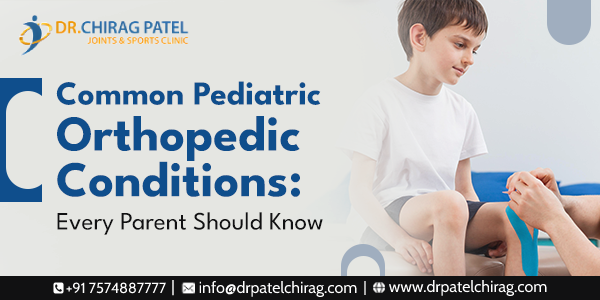Pediatric orthopaedic conditions, when ignored and left untreated, can have serious complications down the line for the child. Therefore, it is crucial to promptly identify orthopaedic conditions that manifest in childhood. Early intervention drastically improves outcomes, mitigates long-term repercussions, and ensures the physical and mental well-being of the child.
“It is not surprising that we often treat ignored orthopaedic conditions which could be treated early for even faster outcomes. Mostly it comes down to awareness among the parents regarding pediatric orthopaedic conditions,” says the leading orthopaedic surgeon in Mumbai, Dr. Chirag Patel.
To help you understand and identify pediatric orthopaedic problems better, we list five common pediatric orthopaedic conditions that are often ignored by parents, so you don’t overlook them.
Five Common Pediatric Orthopaedic Conditions Every Parent Should Know:
- Knock-Knees and Bowlegs: Knock knees is the condition where the legs curve inward, while bowlegs refer to when the legs of the child curve outward at the knees. Both these conditions are common in younger children and often resolve by age 2. However, if these conditions persist beyond early childhood, they can lead to difficulty in walking, running, uneven wear on footwear, and increased risk of arthritis and joint pain later in childhood.
- Pigeon Toeing: Pigeon toeing is another condition often overlooked, characterized by inward-turning feet while walking or standing. Similar to knock knees, it is common in children and typically corrects itself by age 4. However, if it persists after age 4, it can lead to abnormal gait, stumbling, and uneven wear on shoes, ankle pain, and flat feet.
- Limb Length Discrepancy: Limb length discrepancy occurs when one leg of the child is shorter than the other. Causes include growth plate injuries, congenital conditions, and infections, which can lead to pain in the hips, knees, and back over time, affecting walking and running.
- In-Toeing: In-toeing refers to the condition where the feet turn inward when walking or standing, involving the entire foot and ankle. It can contribute to stumbling, tripping, abnormal gait, and foot and ankle problems as the child grows.
- Scoliosis: Scoliosis is a severe condition that may develop in early childhood, presenting with mild symptoms such as uneven shoulders, uneven head position, prominent shoulder blades, and uneven clothing fit. Without treatment, scoliosis can progress, resulting in a curved spine that may be untreatable even with surgery. Parents are strongly advised to consult an orthopaedic surgeon when their child develops any of the above symptoms in their childhood.
All the above conditions are often ignored by parents but are surprisingly easily treated with early interventions. Bracing and physical therapy can help correct knock knees and bowlegs, while stretching and physical therapy can improve pigeon toes. Early intervention for scoliosis can lead to better outcomes. It is always advised to consult an orthopaedic specialist for even minor orthopaedic problems in children. If you are in Mumbai and looking for assistance with pediatric orthopaedic problems, you can contact Dr. Chirag Patel





